I first began to think about this post a few weeks ago, then the incomprehensible happened. As I write, and with fighting continuing on the streets of Kyiv, war crimes being cited on the roads outside the city and in Bucha, the brutality of war is now a part of everyday family life for so many.
‘Fear, grief, loss and sadness’, Wordsworth’s ‘still, sad music of humanity’ has reached Ukraine and beyond
William Wordsworth is understood by most scholars to have written ‘Tintern Abbey’ , as a response to the turmoil of the French Revolution. Once the radical action became more violent Wordsworth went ‘to nature to get away from the dreadfulness’ . The poem includes his acknowledgement that ‘returning to nature and reflection of the landscape comforted him from “the fever of the world”‘.
It’s no secret that I immersed myself in the details of my horticultural exploits following a personal loss several years ago. Developing a green space in rather inauspicious circumstances became a rewarding, absorbing and steadying occupation. The fragmented outdoor space, together with our recently acquired top floor home, was in itself a replacement for the original roof of the converted Edwardian secondary school, which had been lost to an incendiary bomb in the second world war. So, many bags of compost later, many deliveries of pots and plants, and untold hours tending the various small trees, shrubs and perennials as well as seasonal plants (and with grateful thanks to the water supply courtesy of our kind neighbour) a garden, of sorts, has emerged.
During the early days, and still at certain moments, it was the involvement in the details of another world that helped me through. Individual plants lend themselves to close observation and so it was that I came through an intensely difficult period with newly acquired knowledge and renewed enthusiasm. Days spent away from the plants, because of work or other plans, as well as the vagaries of the weather, left me unsettled, whereas returning to the plant life around me was always settling. It didn’t seem to matter that it was an awkward undertaking with much to learn and many setbacks.
Storm Eunice
We were lucky. The stately lime trees that fringe the grounds below stayed rooted to the spot and although twigs and smaller branches were scattered around, mingled with sheets of cardboard and other domestic debris, no significant damage was done. Up aloft I’d taken precautions, lashing anything that I could to the railings and moving all the smaller pots to sheltered corners while regretting not watering some of the containers before the worst of the storm arrived. The earlier winds had dried out the larger planters leaving them more vulnerable to the onslaught to come. One such unstable container, occupied by a ‘lollipop’ dwarf eucalyptus gunii (surprising but true, as eucalyptus gunii is a native of Tasmania where it is known as cider gum and will grow up to 35 metres in height) spun out of control before I reached it, landing on the elderly rose I mentioned in my last ‘Retiring Gardener’ post. In a brief moment of respite I managed to haul the eucalyptus and pot upright and belatedly tie it to the railings.
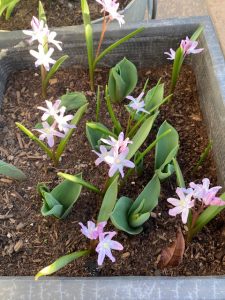 The rose was unscathed but much plant life across the country was irrevocably lost or damaged – heartbreaking and worrying for individual gardeners, all plant lovers, and many others, but trees and ornamental plants have considerable powers of recovery. Nearby, Spring has arrived in Richmond Park and the scars of Winter are in retreat thanks both to the wonders of nature and the park’s workforce, guardians of both the trees and the deer who live amongst them, eating grass and leafy shoots.
The rose was unscathed but much plant life across the country was irrevocably lost or damaged – heartbreaking and worrying for individual gardeners, all plant lovers, and many others, but trees and ornamental plants have considerable powers of recovery. Nearby, Spring has arrived in Richmond Park and the scars of Winter are in retreat thanks both to the wonders of nature and the park’s workforce, guardians of both the trees and the deer who live amongst them, eating grass and leafy shoots.
Pottering On
I’m not keen on potting on seedlings and potbound plants so I’ve always tended to be lazy and leave it to the last moment and/or repot into planters much bigger than the original. I’ve long known that you should only go up one size or so rather than leap ahead, but I’ve never known why. On the whole this hasn’t been a problem and I’ve opportunistically used the excess space in the planter around the specimen plant for extra herbs as well as seasonal bulbs or plants I’ve over-ordered. As time passes, and if all goes well, the feature plant will start to get cramped at which point I remove any remaining smaller plants (to re-home if possible) feed and water the now appropriately sized planter and wait for its occupant to spread its roots.
However, I now understand that if you don’t pot on in the advised way, an immature root system can get waterlogged with roots rotting off if left in overly wet compost for too long. So it seems that competition from the underplanting may be helping to keep the compost from being too wet for too long. This approach has been pretty successful over the years so I’m planning to continue in the same vein (but better informed) as it has avoided too much potting on, which, if your outdoor space is on the top floor and faces the prevailing winds, requires waiting for a very still day in order to prevent the loss of valuable compost which will blow around at every opportunity.
Sadly we lost our sweet box, Sarcococca confusa, late last year after several years of scent and subtle flowers. It had had enough of life in a container, having more recently yearned it seemed for open ground, and more particularly a shady spot, but it is on the short list to try again as I am trying to create a less exposed, shady area on the balcony, close to the one and only seating area. However, this project has been set back by the Winter weather as one of the beautiful E Nicholii (a smallish narrow leaved eucalyptus) with the potential to provide some shade, has lost much of its foliage and will take time to recover.
Planting tip : On the other hand Tulbulgia are very happy in pots and planters, as long as they are in full sun, but they are greedy and will take over any container very quickly, so in my experience are generally best raised on their own or with other vigorous plants capable of competing for space. Meanwhile I am waiting anxiously to see how the apricot geum ‘Mai Tai’ and purple salvia ‘Amistad’ that I planted somewhat experimentally with an established tulbughia (thereby breaking my own rule of thumb) will cope this year.
Say it with Flowers
Late Spring on the balcony is tantalising. The plants are coming into growth but the ratio of flowers to compost is still heavily weighted towards too much compost on display and too few flowers. There are many gaps. Sleet in the air deterred some of the Spring bulbs and there were also supply problems in the Autumn when I turned my back on my favourite spring bulb supplier as I couldn’t master the newly introduced ‘improved’ web-site. So a few single spies have come into flower but no battalions yet, although with each day a few more tulip flowers emerge and the rather blowsy short stemmed pink tulips I planted for the first time last November are particularly well worth the wait. I’m assuming that the aberrant lone flower stem that opened out about three weeks ago belonged to a bulb that I had planted much closer (too close for a lengthy life) to the surface of the compost.
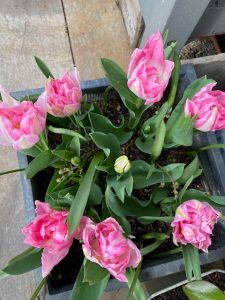
Showing some visitors the roof garden was to be reminded that it is indeed a very small space, that seeing familiar plants can evoke strong feelings, and a sense of home, and that on my part it is somewhat eccentric to be quite so keen to grow Mediterranean plants, pomegranates being one of the latest, at altitude on the outer fringes of the metropolis.
But needs must, preoccupied as I am with the impact of gaps and losses evident amongst the plant life on the balcony where much can be replaced or replenished with lessons learnt along the way. I’m also aware that in much of life, and for many people, the sad music of humanity bangs a very different drum, and the chance to nurture a personal green space, with all it’s potential beauty and other benefits, remains a very distant possibility. Time in nature and community gardening projects are some of the green prescriptions available on the NHS which are increasingly recognised as helpful for people with depression and anxiety disorders, and if you are wondering how to widen your own green options this might be the time to plan some visits to other gardens and check what will be open nearby as part of the National Garden Scheme.
Planting tip: If you are looking for a clematis that flowers early and is happy in a container (although would I’m sure prefer open ground) you might try the evergreen Clematis armandii ‘Apple Blossom’ which has a wonderful display of soft pink flowers for 2 or 3 weeks from early March onwards – pretty, perfumed and a reminder that Spring is on its way.
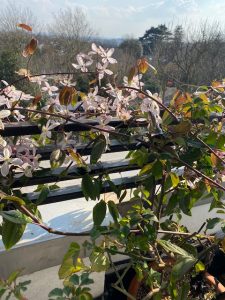
And if you are planning a new garden it might be wise to plan for all the impedimenta that goes with gardening, including young plants, tools, compost; I could go on. Wandering into the main bedroom recently I noticed the rather grubby watering can and a pair of gardening gloves on a rug by the open doors to the main roof garden. Unsurprising in one way as the bedroom is the only gateway to the main planted area outside, but I was also very conscious that not all bedrooms, which in this example is in every other way a conventionally decorated and comfortable space, have to double up as tool shed and plant store on so many occasions.
I am very lucky to live with someone who tolerates all this with barely a murmur.
In Haste
A couple of weeks ago I received an apologetic e-mail from the supplier of the sweetpea seedlings I ordered late last year for the allotment, expressing regret for the anticipated delay in their arrival, predicted to be end of April. I read the e-mail with relief because the designated sweetpea area (one of my few responsibilities) was covered in weeds and had been left out of the recent manuring regime. Actually, fastidious as I am in many respects, I am quite happy to shovel manure when necessary, much less keen to do the hard chore of meticulous weeding at ground level on chilly days.
However, the sweetpeas arrived a month early, coinciding with a late cold snap. The local garden centre didn’t have any tall, compostable plant pots and I needed to give them all more house room. So in the absence of a potting shed or greenhouse the kitchen had to be commandeered alongside my very best stainless steel roasting tin, and with a homage to ‘Blue Peter’ I set to and constructed a makeshift arrangement which would hopefully see the seedlings through until they could be moved on to more suitable accommodation. I imagined too that with time against us we would be packing bags of seed compost and searching for more pots as we travelled West for the Easter weekend.
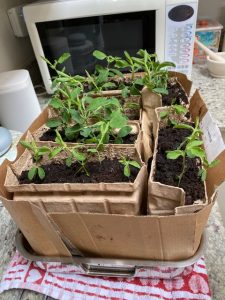
Luckily a green-fingered granddaughter took things in hand.
The makeshift arrangement was already collapsing, so tall party cups were put to good use, a sharp pencil was used to pierce holes in the bottom of each cup, seedlings and compost were carefully introduced to each, and even the weakest seedling was given painstaking attention. Robust enough now, and appropriately housed, they could be transported to another family member for safe-keeping while we were away. I was able to retrieve the roasting tin in time for some seasonal cooking on our return home, although it won’t be until late Summer that the roasted vegetables are all from the allotment, and hopefully the happy enough small sweet pea plants will be ready for the arrival of some benign weather and a warm afternoon when they can be planted out.
Planting tip: In truth I have always coveted the beauty of a rose-filled English country garden in high Summer, but if you have a smaller, quirkier space then you can enjoy the freedom to indulge more idiosyncratic possibilities. In my case, this year it is sparkly solar powered dandelion lights dotted around. Thanks to the longer days they last for several hours into the evening, ready to re-charge and shine again at dusk the following day. I am delighted with them.
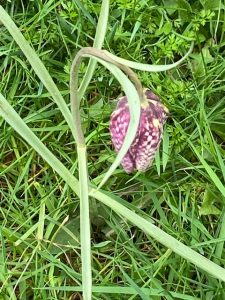 Gardens and gardening are often sociable spaces and activities. Admiring comments are always welcome, help and advice is often freely given and seeds and produce exchanged, and the possibility of contributing to the wider green agenda is rewarding too. Down below the grass bordering the parking area is managed as a wildflower meadow with snake’s head fritillaries now appearing at intervals, hopefully with more to come next year. What’s missing in this urban space is the peace and quiet of the countryside and the views beyond. Of course struggling with a yearning for a bigger space isn’t always easy, but nature has a foothold hereabouts and you might be surprised how successful awkward urban spaces can be at providing calming plant filled oases in a built up area and are increasingly popular with pollinators.
Gardens and gardening are often sociable spaces and activities. Admiring comments are always welcome, help and advice is often freely given and seeds and produce exchanged, and the possibility of contributing to the wider green agenda is rewarding too. Down below the grass bordering the parking area is managed as a wildflower meadow with snake’s head fritillaries now appearing at intervals, hopefully with more to come next year. What’s missing in this urban space is the peace and quiet of the countryside and the views beyond. Of course struggling with a yearning for a bigger space isn’t always easy, but nature has a foothold hereabouts and you might be surprised how successful awkward urban spaces can be at providing calming plant filled oases in a built up area and are increasingly popular with pollinators.
With grateful acknowledgement to Sue Stuart-Smith, author of ‘The Well Gardened Mind’ Rediscovering Nature in the Modern World
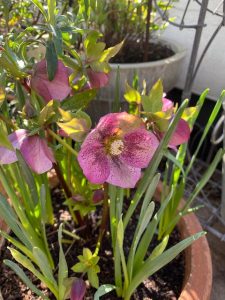
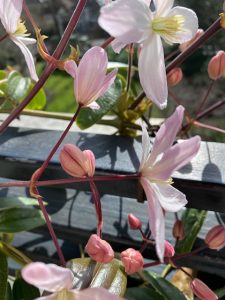
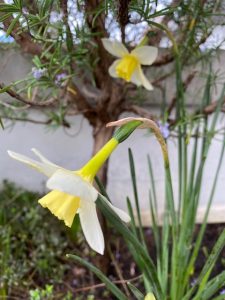
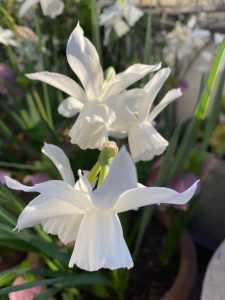
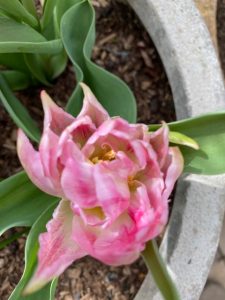
Lovely to read that the granddaughter was helpful and “green fingered”. A proposal of garden jobs is being compiled for when she returns from her grandparents tour today.